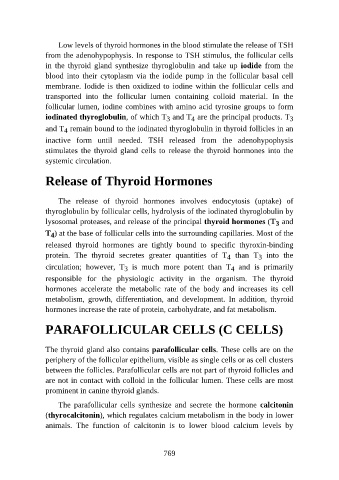Page 770 - Atlas of Histology with Functional Correlations
P. 770
Low levels of thyroid hormones in the blood stimulate the release of TSH
from the adenohypophysis. In response to TSH stimulus, the follicular cells
in the thyroid gland synthesize thyroglobulin and take up iodide from the
blood into their cytoplasm via the iodide pump in the follicular basal cell
membrane. Iodide is then oxidized to iodine within the follicular cells and
transported into the follicular lumen containing colloid material. In the
follicular lumen, iodine combines with amino acid tyrosine groups to form
iodinated thyroglobulin, of which T and T are the principal products. T 3
4
3
and T remain bound to the iodinated thyroglobulin in thyroid follicles in an
4
inactive form until needed. TSH released from the adenohypophysis
stimulates the thyroid gland cells to release the thyroid hormones into the
systemic circulation.
Release of Thyroid Hormones
The release of thyroid hormones involves endocytosis (uptake) of
thyroglobulin by follicular cells, hydrolysis of the iodinated thyroglobulin by
lysosomal proteases, and release of the principal thyroid hormones (T and
3
T ) at the base of follicular cells into the surrounding capillaries. Most of the
4
released thyroid hormones are tightly bound to specific thyroxin-binding
protein. The thyroid secretes greater quantities of T than T into the
3
4
circulation; however, T is much more potent than T and is primarily
3
4
responsible for the physiologic activity in the organism. The thyroid
hormones accelerate the metabolic rate of the body and increases its cell
metabolism, growth, differentiation, and development. In addition, thyroid
hormones increase the rate of protein, carbohydrate, and fat metabolism.
PARAFOLLICULAR CELLS (C CELLS)
The thyroid gland also contains parafollicular cells. These cells are on the
periphery of the follicular epithelium, visible as single cells or as cell clusters
between the follicles. Parafollicular cells are not part of thyroid follicles and
are not in contact with colloid in the follicular lumen. These cells are most
prominent in canine thyroid glands.
The parafollicular cells synthesize and secrete the hormone calcitonin
(thyrocalcitonin), which regulates calcium metabolism in the body in lower
animals. The function of calcitonin is to lower blood calcium levels by
769

